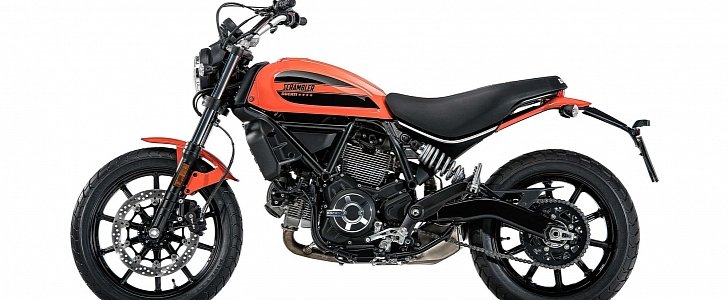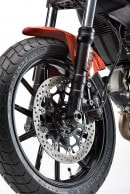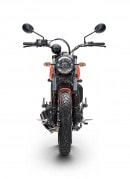After Ducati stormed last year’s edition of EICMA with its Scrambler, the company decided to repeat the move for the 2015 event, albeit halving the model in its quest to reach out to entry-level riders.
Dubbed Scrambler Sixty2, the new machine is motivated by a 399cc engine, which offers half of the standard Scrambler’s 803cc displacement, while the rest of the bike is pretty close to its more serious sibling.
While the normal Scrambler has an 88mm bore and a 66mm stroke, the 399cc version changes that to a 72 x 49mm setup, whilst offering the same air-cooled L-Twin configuration.
A somewhat similar halving scheme is applied to the output, with the Scrambler’s 75 hp and 50 lb-ft (68 Nm) of twist being scaled down to 41 hp and 25 lb-ft (34 Nm) of torque.
In terms of the chassis, the steel trellis frame is kept, but unlike in the case of the normal Scrambler’s inverted Kayaba fork, the Sixty2 packs a normal-position Showa Fork. There’s a Kayaba rear damper that can be adjusted for preload, while the wheel travel of 5.9 inches (150mm), offered at both ends of the bike, mirror that of the original bike.
The same can be said about the 4.4 inches (112mm) of trail and the 24-degree rake angle, but the wheelbase has jumped 0.6 inches (152mm) to 57.5 inches (146mm) for the all-important, especially for the targeted riders, stability.
Sure, the engine might follow the scheme mentioned above, but when it comes to the scales, the Sixty2 sits at 403 lbs (182 kg) in wet form, which means it’s only 8 lbs (3.6 kg) lighter compared to the standard Scrambler.
Given the negligible weight difference, we were surprised to see Ducati replacing the 803cc Scrambler’s front brake (330mm disc and a four-piston caliper) with a setup featuring a 320mm rotor and two-piston floating calipers.
Until the Sixty2’s pricing and availability are announced, we invite you to check out the spec sheet below.
While the normal Scrambler has an 88mm bore and a 66mm stroke, the 399cc version changes that to a 72 x 49mm setup, whilst offering the same air-cooled L-Twin configuration.
A somewhat similar halving scheme is applied to the output, with the Scrambler’s 75 hp and 50 lb-ft (68 Nm) of twist being scaled down to 41 hp and 25 lb-ft (34 Nm) of torque.
In terms of the chassis, the steel trellis frame is kept, but unlike in the case of the normal Scrambler’s inverted Kayaba fork, the Sixty2 packs a normal-position Showa Fork. There’s a Kayaba rear damper that can be adjusted for preload, while the wheel travel of 5.9 inches (150mm), offered at both ends of the bike, mirror that of the original bike.
The same can be said about the 4.4 inches (112mm) of trail and the 24-degree rake angle, but the wheelbase has jumped 0.6 inches (152mm) to 57.5 inches (146mm) for the all-important, especially for the targeted riders, stability.
Sure, the engine might follow the scheme mentioned above, but when it comes to the scales, the Sixty2 sits at 403 lbs (182 kg) in wet form, which means it’s only 8 lbs (3.6 kg) lighter compared to the standard Scrambler.
Given the negligible weight difference, we were surprised to see Ducati replacing the 803cc Scrambler’s front brake (330mm disc and a four-piston caliper) with a setup featuring a 320mm rotor and two-piston floating calipers.
Until the Sixty2’s pricing and availability are announced, we invite you to check out the spec sheet below.
- Engine: 399cc air-cooled L-Twin
- Bore x Stroke: 72 x 49mm
- Compression Ratio: 10.7:1
- Power: 41 hp @ 8750 rpm / 25.3 lb-ft @ 7750 rpm
- Fuel system: Electronic fuel injection
- Transmission: 6-speed
- Clutch: Wet multiplate, cable-actuated
- Final Drive: Chain (15/48)
- Frame: Tubular steel trellis
- Front Suspension: 41mm Showa fork, with 5.9 inches of travel
- Rear Suspension: Kayaba rear shock, pre-load adjustable, with 5.9 inches of travel
- Front/Rear Tires: Pirelli MT 60 RS 110/80 R18; 160/60 R17
- Front Brake: 320mm disc, 2-piston floating caliper
- Rear Brake: 245mm disc, single-piston floating caliper
- ABS: Bosch 9.1 MP (standard)
- Wheelbase: 57.5 inch
- Rake/Trail: 24° / 4.4 inch
- Seat Height: 31.1 inch standard, with 30.3 and 31.9 inch accessory options
- Fueltank Capacity: 3.7 gallon
- Dry/Wet Weight: 368/403 pounds






































